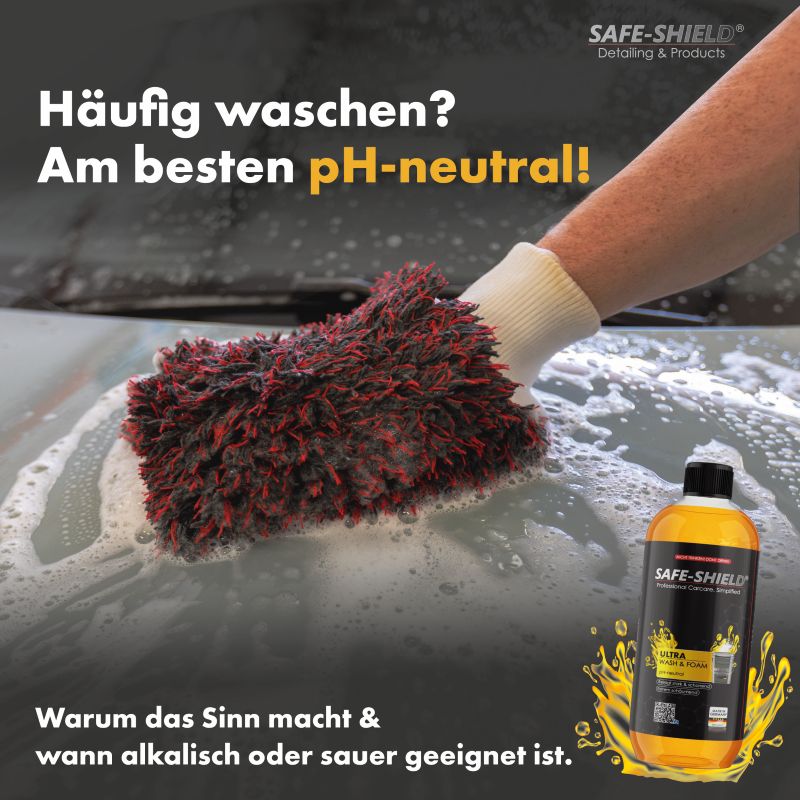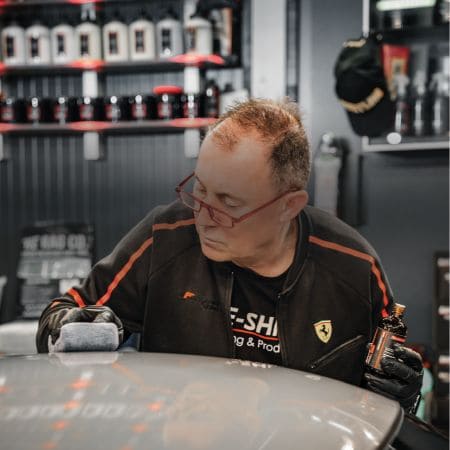Washing your car the right way: pH-neutral for everyday use—acidic & alkaline cleaners only when necessary
This guide explains how often you should wash your car, why pH-neutral shampoo is the safest foundation, and in which special situations acidic or alkaline cleaners make sense. Also included: a paint-safe hand wash guide, common mistakes, and a detailed FAQ.
Why pH Level Matters
The pH value of a cleaner affects how aggressively it acts on dirt—but also on materials and protective layers. pH-neutral (around pH 7) is usually gentle on paint and less likely to attack intact coatings. Acidic cleaners can dissolve mineral residues (e.g., water spots from hard water) more effectively; alkaline cleaners are particularly effective at removing oily/greasy road grime. The key is to use them selectively and keep regular washing gentle.
pH-neutral as the standard for regular washes
For weekly or bi-weekly maintenance, professionals recommend a pH-neutral car shampoo. It cleans thoroughly, is gentle on paint, rubber, plastics, and existing protective layers (wax, sealant, ceramic), and is ideal for regular hand washing.
How often should you wash?
- Year-round daily use: every 1–2 weeks (depending on weather & usage).
- In winter / with road salt: Preferably weekly, to minimize the risk of corrosion.
- After long-distance trips or insect exposure: Wash promptly to prevent residues from drying on.
Targeted acidic cleaning: for mineral deposits & water spots
Acidic products are not for routine washes, but for targeted use only—such as:
- Hard water spots (dried droplets, spray mist from sprinklers)
- Light flash rust/metal particle residue* on smooth surfaces
*For iron fallout, special “iron removers” (pH-adjusted, reducing chemistry) are often the first choice. Always follow manufacturer instructions.
Important: Acidic cleaners can attack sensitive materials (e.g., bare metals). Always check material compatibility, work in a cool, shaded area, and rinse thoroughly right away.
Targeted alkaline: for greasy road grime
Alkaline pre-cleaners/pre-washes are powerful against greasy road grime, oil, diesel soot, or insect residues. Use them before hand washing to loosen dirt and minimize scratches during contact washing. Always follow up with a pH-neutral shampoo for hand washing.
Note: Frequent or overly strong alkaline applications can weaken wax-based protective layers. Follow the recommended dosage and contact time, and never let the product dry on the surface.
How-to: Paint-friendly hand wash (step by step)
Touchless pre-cleaning combined with the two-bucket method reduces wash scratches and preserves protective layers longer.
You’ll need
- 2× professional car wash buckets with grit guard
- Microfiber wash mitt
- pH-neutral car shampoo
- High-quality drying towel, optional snow foam/lance pre-cleaner
-
Pre-clean (minimal contact)
Let the vehicle cool down in the shade. Rinse off loose dirt with water. Optionally, apply snow foam/pre-wash, let it work (don’t let it dry), and rinse thoroughly.
-
Two-bucket setup
Bucket A with shampoo solution, bucket B with clean rinse water—both with grit guards. This keeps the mitt cleaner and reduces scratches.
-
Contact wash from top to bottom
Work with the wash mitt in straight lines (not circular motions). After each section, rinse it in the rinse bucket, then return it to the shampoo bucket.
-
Rinse thoroughly & dry gently
Completely remove shampoo residue. Gently dry with a clean microfiber towel. Optionally, use air to blow water out of crevices.
Quickly solve problems (Troubleshooting)
Water spots after drying
If fresh: Wash the spot again with pH-neutral shampoo and dry immediately. For stubborn, mineral-rich stains: Treat with a suitable mild acidic product, then rinse thoroughly to neutralize.
Oily road film remains visible.
Before hand washing, briefly use a suitable alkaline pre-cleaner, then follow up with a pH-neutral shampoo.
Insect residues
Soak promptly (pre-wash/soak), never rub dry. Then wash as usual.
Matte or satin finishes
Only use pH-neutral, approved products. Do not use polish-like products or gloss enhancers.
FAQ: Frequently Asked Questions
How often should I wash my car?
As a rule of thumb: every 1–2 weeks. Wash more often if there’s road salt, heavy pollen, or after long trips.
Does pH-neutral shampoo affect wax or ceramic coatings?
pH-neutral shampoos are designed for regular care and protect intact protective layers. However, the strength and durability of the coating still depend on the product, preparation, and usage.
When is an acidic cleaner appropriate?
Specifically for mineral residues such as limescale water spots. Always work gently on materials, observe dwell time and compatibility, and rinse thoroughly.
When should I use an alkaline cleaner?
For stubborn, greasy road grime, use as a quick pre-clean. Then hand wash with a pH-neutral shampoo.
Are household products like dish soap a good alternative?
No. Dish soap is not formulated for vehicle surfaces and can compromise protective layers. It’s better to use a suitable, pH-neutral car shampoo.
What basic equipment do I need for a paint-safe wash?
At minimum: pH-neutral car shampoo, microfiber wash mitt, two wash buckets with grit guard, and a clean drying towel.
Safety & Information
- Never work in direct sunlight or on hot paint; do not allow products to dry on the surface.
- Always test on an inconspicuous area first and follow the manufacturer’s instructions.
- Do not mix acidic and alkaline cleaners; wear protective gloves/goggles depending on the product.
- After specialty cleaning, rinse the surface thoroughly.




Laisser un commentaire
Tous les commentaires sont modérés avant d'être publiés.
Ce site est protégé par hCaptcha, et la Politique de confidentialité et les Conditions de service de hCaptcha s’appliquent.